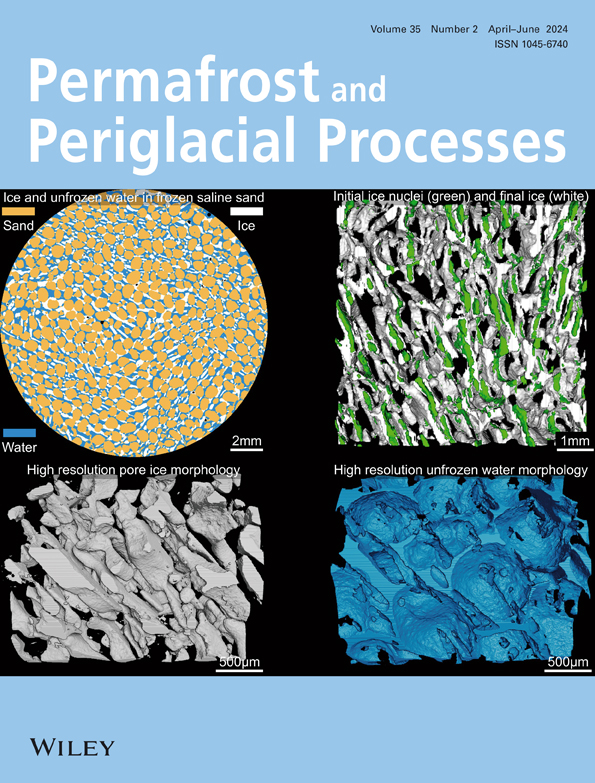实验霜冻作用揭示的影响寒冷气候风成石英颗粒微结构发育的因素
IF 3.3
3区 地球科学
Q2 GEOGRAPHY, PHYSICAL
引用次数: 2
摘要
风成石英砂粗粒(0.5-1 mm)经受了冻融风化试验。在充分水分条件下,模拟了1000个温度范围为- 5至+10°C的冻融循环。通过对冻融循环0、50、100、300、700和1000次后的颗粒表面进行扫描电镜显微结构分析,发现不同大小的贝壳状断裂和破碎块是冻融诱导的显微结构。这些微织构绝大多数出现在风成颗粒最凸起的部分,它们的数量随着冻融循环的进行而增加。然而,记录到的霜源微结构的数量在700次冻融循环后仍然相对较少,在1000次冻融循环后增加。经过0、100和1000次冻融循环后的透射电镜显微结构分析显示,石英晶体中既有原生缺陷(如包裹体、晶界),也有次生缺陷(如裂纹)。后者的频率仍然出乎意料地低。风成砂大小的石英颗粒对霜冻引起的变化的敏感性主要取决于它们的内部特征。其中包括风沙驱动的地下冲击区发育,该影响区决定了霜源微纹理发育的深度。外部撞击区由一层薄薄的表层地壳和一系列或多或少平行的山脊组成,这些山脊排列成机械上翻的板块。内部冲击区由完整或破碎的石英晶体组成。因此,风成石英颗粒对霜冻引起的变化的敏感性取决于内部因素(即石英颗粒的原始晶体学)和外部因素(即作用于颗粒的风成和霜冻过程)的组合。本文章由计算机程序翻译,如有差异,请以英文原文为准。
Factors influencing the development of microtextures on cold‐climate aeolian quartz grains revealed by experimental frost action
Aeolian‐originated quartz grains of coarse‐sand size (0.5–1 mm) were subjected to experimental frost weathering. A total of 1,000 freeze–thaw cycles with temperature ranges from −5 to +10°C were simulated under full water availability conditions. Scanning electron microscope microtextural analysis of grain surfaces conducted after 0, 50, 100, 300, 700, and 1,000 freeze–thaw cycles resulted in different‐sized conchoidal fractures and breakage blocks as frost‐induced microtextures. The vast majority of these microtextures were encountered on the most convex parts of aeolian grains and their number increased with ongoing freeze–thaw cycles. However, the number of recorded frost‐originated microtextures remained relatively small up to 700 freeze–thaw cycles and increased after 1,000 freeze–thaw cycles. Transmission electron microscope microstructural analysis of grains after 0, 100, and 1,000 freeze–thaw cycles showed both primary (e.g., inclusions, grain boundaries) and secondary (e.g., cracks) defects in quartz crystals. The frequency of the latter remained unexpectedly low. The susceptibility of aeolian‐originated sand‐sized quartz grains to frost‐induced modifications is interpreted here to depend mainly on their internal characteristics. These include aeolian‐driven development of a subsurface impact zone that determines the depth to which frost‐originated microtextures develop. The outer impact zone consists of a thin layer of surficial crust and a series of more or less parallel ridges arranged into mechanically upturned plates. The inner impact zone consists of intact or cracked quartz crystals. The susceptibility of aeolian‐originated quartz grains to frost‐induced modifications depends therefore on a combination of internal (i.e., original crystallography of quartz grains) and external (i.e., aeolian and frost processes acting upon the grains) factors.
求助全文
通过发布文献求助,成功后即可免费获取论文全文。
去求助
来源期刊
CiteScore
9.70
自引率
8.00%
发文量
43
审稿时长
>12 weeks
期刊介绍:
Permafrost and Periglacial Processes is an international journal dedicated to the rapid publication of scientific and technical papers concerned with earth surface cryogenic processes, landforms and sediments present in a variety of (Sub) Arctic, Antarctic and High Mountain environments. It provides an efficient vehicle of communication amongst those with an interest in the cold, non-glacial geosciences. The focus is on (1) original research based on geomorphological, hydrological, sedimentological, geotechnical and engineering aspects of these areas and (2) original research carried out upon relict features where the objective has been to reconstruct the nature of the processes and/or palaeoenvironments which gave rise to these features, as opposed to purely stratigraphical considerations. The journal also publishes short communications, reviews, discussions and book reviews. The high scientific standard, interdisciplinary character and worldwide representation of PPP are maintained by regional editorial support and a rigorous refereeing system.

 求助内容:
求助内容: 应助结果提醒方式:
应助结果提醒方式:


